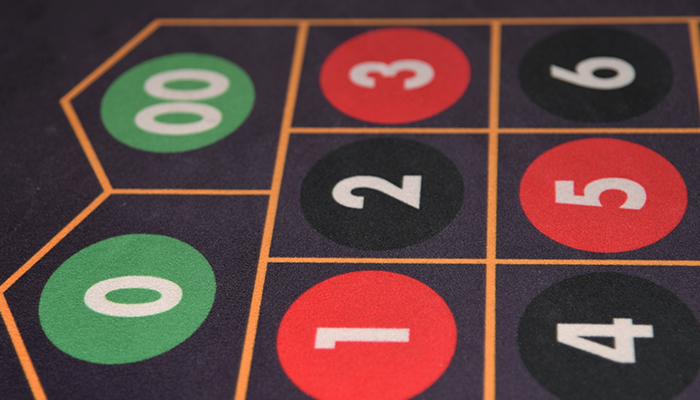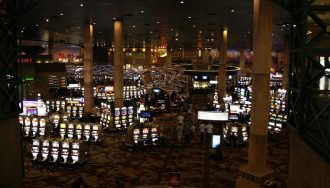American vs European Roulette: What Is the Difference?
 American vs European Roulette
American vs European Roulette
Before online casinos reached the point where everyone had an entire casino worth of games in their back pocket, many Americans had never heard of European Roulette, and any European roulette players who saw the American version of the game probably stayed well clear.
The biggest difference is that European roulette has only one green zero, while the American version has two. Yet they pay the same on all of the bets. The addition of a second zero more than doubles the house advantage.
Now that most online casinos offer both versions of the game, it is easy to see that when discussing American vs European roulette, one is clearly superior, and that the house edge on the other can rather quickly drain your bankroll. But before we get to that, first a little history.
- 🎡 How American Roulette Rules Came to Be
- 🎡 How European Roulette Rules Came to Pass
- 🎡 What Does an American Roulette Wheel Look Like?
How American Roulette Rules Came to Be?
American Roulette began, as many wonderful things do, in Paris in the early 1790s. Our current game of roulette was transformed there into the one we play today from earlier French versions of the games that had been bouncing around Europe for the better part of a century.
Where American Roulette Rules Came From
The game, as then played in Paris, had two zeros on the wheel head, though they weren’t green quite yet. But the number of zeros, along with the payouts, are what we now think of as American roulette today. Thirty-five to one on straight-up numbers, seventeen to one on splits, eight to one on corners. The basket, which is the 0, 00, 1, 2, 3, pays six to one in this version of the game with American Roulette rules. While the street or three across bet pays eleven to one, and the double street pays five to one.
It quickly spread to French parts of the New World, but most famously to New Orleans, where it made its way up the Mississippi River. It was an integral part of the historical riverboat gambling scene that would sear the public imagination and continue for another 100 years.
River Boats and Cow Towns
Those first games on the river boats had to be smaller and less ornate than the ones in the drawing rooms and gambling dens of Paris, both because of the size of the boats and because of their intended consumers. As the game leapt from the river to mining and cow towns across the American West, this sense of austerity stayed with the game, which limited the number of outside bets to just red/black, even/odd, and 1-18/19-36—followed by the two-to-one bets of either columns or dozens.
Finally, in the 1980s and 90s, states like New Jersey, Mississippi, and Louisiana began to make gambling legal in certain coastal zones or rivers where gambling had once flourished. Sovereign Indian tribes also began to take advantage of federal laws that allowed them to offer gaming in some circumstances. By 2024, there were about 1,000 US casinos, about equally split between commercial casinos and those on tribal land.
So, the American Roulette Wheel
It turns out that American vs European roulette is simply old French roulette rules vs new rules added by a succession of European casinos to entice more gamblers.
How European Roulette Rules Came to Pass?
So, if American roulette was passed down virtually unchanged from French roulette at the turn of the 19th century, why does European roulette only have one zero and so many other bets you can make?
Spa Towns and Swindlers
The answer lies with Louis Blanc and his brother Francois and starts but doesn’t truly end in the town of Bad Homburg in what is now the German state of Hesse. In 1839, a new Landgrave came to power in the area, and like so many Landgraves before him, Philip August Frederick was broke. His soon-to-be saviors, Francois and his twin brother Louis, began their gambling careers by running off with the circus at an early age.
After learning every tip and trick to separate a man from his money, they went on to open their own gambling-like businesses in the Port town of Marseilles, where there was plenty of gullible seaman with fat purses to fleece. They soon branched out into that last bastion of every degenerate gambler: land development and stock schemes.
But the constabulary caught up with them after a somewhat notorious case of insider trading on the nascent French stock exchange, basically paying off the French telegraph office to get stock quotes ahead of others.
Fortunately, the laws of the time had yet to catch up with many of their more advanced schemes, and they did scant prison time, but sensing bad times ahead, they moved on after a quick stop in Paris and then over to Luxembourg to make the acquaintance of Landgrave Frederick who obviously knew talent when he saw it. He quickly put the brothers to use, setting up a casino and attempting to draw tourists to Bad Homburg, which was a second-tier spa town in need of cash.
Genesis of European Roulette
By 1843, they had invented a roulette game with only one zero, which would cut the house edge in half but might draw bigger and potentially more lucrative crowds. Some evidence suggests that this was already tried in some casinos and saloons in Paris before gaming was outlawed there in 1836.
Bad Homburg lies just north of Frankfurt, so it would have drawn more from French towns like Metz and Strasbourg, as well as Nancy. In any case, all indications are that the casino and its single zero roulette game were a smash hit, and Francois Blanc even earned the nickname of The Wizard of Homburg.
The Rise of Monaco
A bit further south, another group of broke royalty, the Grimaldi, who ruled over Monaco, were also attempting to use the spa and casino idea, but with little results. The confluence of gambling and spas came from an 1806 Napoleonic Law that relaxed gambling laws around spa towns. Soon, the French and most of Europe would come to equivocate spas with casinos.
In any case, Princess Caroline of Monaco was in dire need of money, and assuming, probably rightfully so, that Monaco lacked much else, she set her sights on a spa and casino to jump-start the tourist industry, so the temporary casino was finished in 1856.
The temporary casino quickly went through several hands as a money-losing proposition. There were just no roads into Monaco, and the people there had no more money than their rulers.
Princess Caroline, also a known nose for talent, eventually won Francois Blanc to the task of running and expanding the now-completed Monaco casino in 1863. He once again put his single zero roulette game front and center to attract players from Paris and elsewhere.
Using his many connections, he raised a vast sum of Francs to build roads and railways in the area. He also hired the noted architect, Garnier, fresh off his Paris Opera House triumph, to build the casino expansion with the Salle Garnier concert hall front and center.
By the time Francois died in 1877, his legacy of Monte Carlo and the single zero wheel would live on in perpetuity.
Attracting Royalty Changes Roulette
The other thing to remember about European Roulette rules is that before and after the French Revolution, the game was played by aristocrats as well as the poorer class. Huge sums were wagered at Versailles and later at salons on Rue de la Grange-Bateliere, the Frescati along the Rue Richelieu, and other gambling houses in the Palais Royale and throughout Paris.
With two zeros out of 38 numbers, the house has an advantage of 5.26%. At only 20 spins in an hour, a roulette player will lose one average bet per hour. But of course, if the game is quicker, say 40 hands per hour, a Vicomte or a Marquis could lose two average bets per hour.
That might not sound like a lot, but if someone is betting thousands of francs a spin, it quickly adds up, especially when so many of Paris’s fashionable gamblers are playing every day for hours at a time. A player losing one average bet every twenty hands might quickly decide that they don’t want to keep playing.
But what if we take away just one zero? Does the house lose money? Now that the house edge has decreased to 2.6%, it takes the player 40 hands to lose one average bet, but many more people wish to play and play longer. Counterintuitively, the house is making more money.
Now, if our clientele is all of the upper crust and is betting large sums, then we can afford to tweak the European roulette rules even further. Perhaps if they are betting on the outside bets, black/red, even/odd, Hi/Lo, and the zero were to spin, we could provide a further reduction in house edge.
The French Take European Roulette One Step Further
After all, some of these houses were reputed to be bringing in tens of thousands of francs a night. So, tweaking the rules a bit further leads us to two more rules that are common in European roulette: En Prison, meaning literally in prison or locked up, and la partage, meaning to share or divide.
While basically the same sentiment, the two rules work a bit differently in practice. With En Prison, if zero rolls, your outside bets don’t lose but are marked up and must remain until the following spin, where either they win or lose. With La Partage, those bets lose half, meaning the bet is divided into two parts, with half to the house and half back to the player.
This rule further reduces the house advantage on outside bets to 1.3% but almost certainly encouraged players to switch to those games where it was offered and probably to make bigger bets for longer.
The Arrival of Announced Bets
The final difference in European roulette rules is that there are many more bets, and most of them have to do with adjacent numbers on the wheel head. You will often notice that European wheels have a racetrack-like symbol on the layout that denotes the numbers on the wheel.
This is used for announced bets, like Voisin Du Zero, Orphelins, Tiers Du Cylinder, Jeu Zero, and Neighbours. These will cover sections of the wheel or sometimes sections of numbers across each other on the wheel.
European Roulette Rules Today
So American vs European Roulette comes down to Europe having a much more well-heeled gambler and the many changes made over two hundred years to attract that upper-crust clientele looking for a deal. The Europeans attempted to entice bigger players with better rules, while most American gamblers came from the working class and even today mostly lack the pricing power to force American casinos into taking away the double zero on the American roulette wheel.
What Does an American Roulette Wheel Look Like?
The most defining characteristics of the American roulette wheel are the 0 and 00 symbols and the fact that the numbers on an American roulette wheel are in a different order than those of the European roulette wheel. Also, almost all American roulette wheels have the outside bets and the dozens placed on the side away from the table games pit, with no one allowed to come around on the dealer side of the wheel.
European roulette wheels, on the other hand, will have only a single zero symbol. They will have the numbers on the wheel head in a different order than those found on American roulette wheels. You will often see the racetrack symbol, which allows the dealers to make the announced bets. Also, you may see signage announcing whether this wheel uses either the En Prison or La Partage rule.
The European roulette table, with a house edge as low as 1.35% on the outside numbers and 2.6% on inside bets, is obviously worth seeking out if you are playing online. The best roulette sites will offer European roulette with French rules, meaning either La Partage or En Prison. Not all games offered as European roulette rules will include these, so seek out French rules.
These will also include the announced bets, which don’t decrease the house edge but which many enjoy playing. On the American roulette wheel, you will lose your money twice as fast on the inside numbers and 4x as fast if the European roulette wheel offers La Partage or En Prison.
Unfortunately, if you are in the US and not playing online, the odds of finding a European roulette wheel are vanishingly small unless you are in Las Vegas, in a high-limit room at someplace like Bellagio or Wynn.




